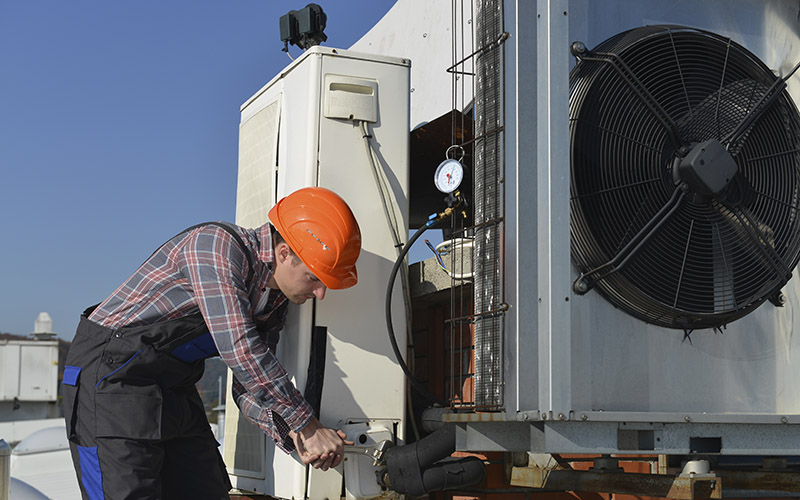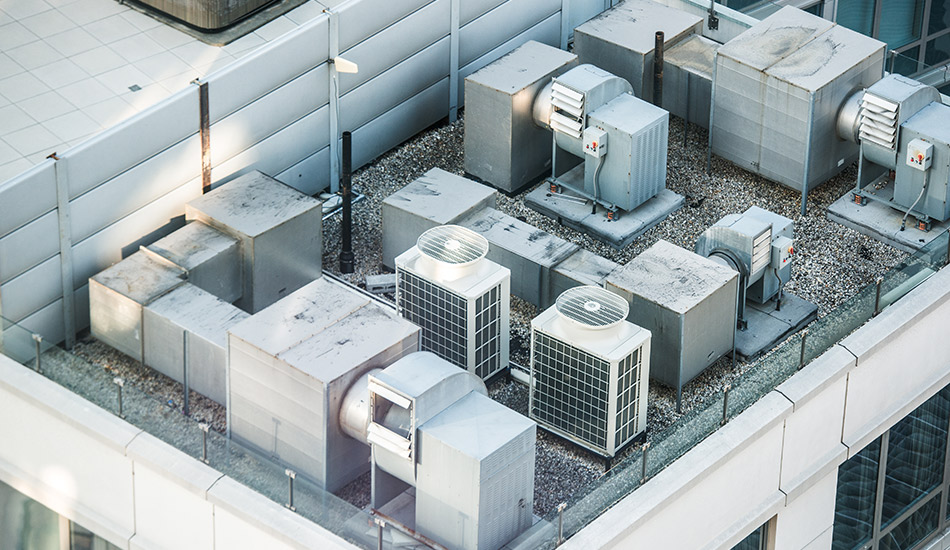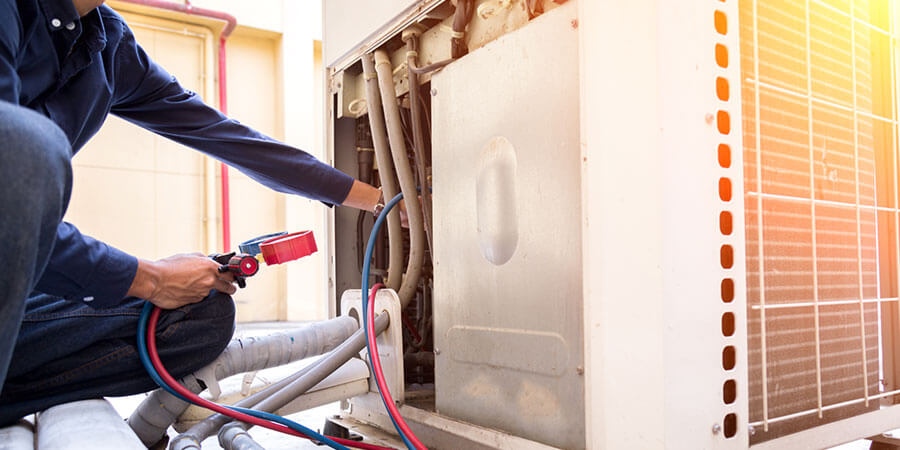Just How a Heatpump and Heating System Collaborate to Maximize Your Home's Heating Efficiency
Recognizing how a warmth pump and heater collaborate is necessary for property owners looking for reliable heating options. Each system has its toughness, supplying a balanced method to home comfort. The warm pump stands out in modest temperatures, while the heating system supplies quick warmth during extreme cold. This synergy not only reduces energy costs but additionally boosts the life expectancy of both home appliances. What variables affect this collaboration, and exactly how can home owners maximize their advantages?
Recognizing Warm Pumps: How They Work
Numerous individuals may be unknown with their internal workings, heat pumps play a crucial function in modern-day home heating systems. These gadgets run by moving warm from one area to another, making use of the concepts of thermodynamics. In cooler months, a warm pump extracts warm from the outside air, ground, or water, and transfers it indoors to warm the living space. On the other hand, during warmer months, it can reverse the procedure, acting as an ac unit by removing warmth from inside to the outside.Heat pumps contain an evaporator, compressor, condenser, and development shutoff. The cooling agent within the system soaks up heat as it evaporates at low temperatures and pressures. The compressor then increases the pressure and temperature of the refrigerant, allowing it to release heat as it condenses. This efficient process can considerably minimize power usage contrasted to standard heating techniques, making heatpump a sustainable choice for climate control in homes.
The Role of Furnaces in Home Home Heating
Heaters play an important function in home heating by offering a reputable resource of warmth during the colder months. They operate by generating heat via burning or electrical resistance, dispersing it throughout the home by means of air ducts or radiant systems. The efficiency of a heater is often measured by its Yearly Fuel Usage Effectiveness (AFUE) rating, which shows exactly how properly the unit converts fuel right into heat.Furnaces can use various power sources, consisting of gas, electrical power, oil, or gas, allowing home owners to select the most appropriate option for their requirements. Unlike heat pumps, which might struggle in extreme cool, furnaces keep constant performance, ensuring that indoor temperature levels stay comfortable regardless of exterior conditions. Additionally, modern-day furnaces frequently come equipped with innovative technology, such as wise thermostats and variable-speed blowers, boosting their effectiveness and responsiveness. This versatility makes heaters a critical element in all-inclusive home heating strategies.

Advantages of Utilizing Both Equipments Together
Integrating the staminas of both furnaces and heatpump can bring about a more efficient and effective home heating service. Making use of both systems permits home owners to capitalize on the warm pump's energy efficiency throughout milder temperatures while relying upon the heater for more severe cold problems. This double method can considerably decrease energy prices, as warmth pumps take in less electrical energy than traditional heating techniques when temperatures are moderate.Additionally, making use of both systems together can enhance comfort levels in the home. Heatpump can supply constant, even heating, while furnaces can quickly elevate ambient temperatures when needed. In addition, the integration of both systems can extend the lifespan of tools by minimizing deterioration on each system, as they share the work. Ultimately, home owners can take pleasure in a balanced, economical home heating service that adjusts flawlessly to varying climate condition, making sure a cozy and welcoming home throughout the winter months.
Exactly How Warmth Pumps and Furnaces Enhance Each Other
They produce a complementary home heating system that makes the most of effectiveness and comfort when property owners integrate warm pumps and heaters. Heatpump run by transferring heat from the outside air or ground, making them highly efficient in moderate climates. They excel during milder temperatures, offering affordable heating. On the other hand, heating systems produce warm with combustion or electric resistance, supplying solid, prompt heat during extreme chilly conditions.The mix of these 2 systems permits dynamic modifications based upon temperature level fluctuations. Throughout warmer months or milder winter months days, the warm pump can take the lead, preserving power and decreasing expenses. As temperatures decrease, the furnace can seamlessly engage, ensuring regular heat throughout the home. This synergy not just maximizes energy usage yet likewise enhances the life-span of both systems, as each system operates within its perfect performance array. Together, they create a well balanced atmosphere that adapts to differing climate demands.
Maximizing Effectiveness: Tips for Homeowners
House owners can improve i loved this their heating performance via numerous functional techniques. Establishing a routine maintenance timetable, incorporating wise thermostat innovation, and carrying out reliable insulation and sealing solutions are crucial steps. These procedures not just improve convenience however also minimize energy prices.
Routine Upkeep Arrange
To assure maximum home heating performance, establishing a regular upkeep schedule is crucial for any kind of home. House owners should prioritize regular assessments of both heatpump and heating systems to ascertain peak efficiency. This consists of changing air filters every one to three months, as clogged up filters can significantly minimize performance. Additionally, scheduling expert upkeep at the very least once a year enables technicians to determine and address prospective concerns before they intensify. Homeowners ought to likewise cleanse the heatpump's outdoor system to stop debris accumulation that can hinder airflow. By adhering to a normal maintenance routine, homeowners not only boost their heating systems' performance however additionally extend their lifespan, resulting in greater convenience and reduced energy prices throughout the cooler months.
Smart Thermostat Integration
Integrating a wise thermostat right into a home heater can considerably enhance power effectiveness, specifically as it enables precise control over temperature setups. These tools can find out the home owner's timetable and choices, automatically changing the temperature level to optimize convenience while decreasing power use. They can decrease home heating during times when the home is empty, lowering unneeded consumption. Numerous wise thermostats find out also offer real-time energy use data, making it possible for house owners to make enlightened choices about their home heating practices. In addition, remote access via smartphone apps allows customers to change settings from anywhere, making certain the home is warm upon return. Overall, wise thermostat assimilation not only enhances comfort however considerably adds to energy financial savings and effectiveness.
Insulation and Securing Solutions
Smart thermostats play an important role in power efficiency, yet their efficiency can be significantly enhanced by appropriate insulation and sealing solutions. Homeowners need to focus on shielding attic rooms, floors, and wall surfaces to minimize warm loss. Premium insulation products, such as spray foam or fiberglass, can substantially improve thermal resistance. Additionally, sealing spaces around windows, doors, and ducts prevents chilly air infiltration and warm retreat. Weatherstripping and caulking work approaches for dealing with these leakages - ductless mini splits. Routine evaluations for air leakages, together with making use of blower door tests, can assist recognize issue locations. By spending in insulation and sealing, house owners can maximize the efficiency of their heating systems, eventually leading to minimized power intake and lower energy expenses
Typical Myths About Heat Pumps and Furnaces
What misunderstandings surround heatpump and heaters? Lots of individuals mistakenly think that heatpump are inefficient in colder environments. In truth, modern heatpump are created to operate efficiently also in low temperatures, offering reliable home heating throughout wintertime. One more usual myth is that heaters are constantly more reliable than heatpump. This depends on the particular energy resources and performance rankings of the units in inquiry. Some may additionally think that utilizing both systems at the same time is unneeded, but in reality, this combination can enhance home heating efficiency, specifically during extreme climate condition. In addition, people often presume that heatpump call for constant upkeep, when actually, they have comparable upkeep requires to conventional heater. By unmasking these myths, homeowners can make even more informed choices concerning their heating alternatives, ultimately causing boosted convenience and energy efficiency in their homes.
Maintenance Factors To Consider for Combined Systems

Frequently Asked Concerns
Can Warmth Pumps Job Effectively in Very Cold Climates?
Heatpump can battle in very chilly climates as a result of lowered efficiency and warm removal constraints. However, developments in modern technology have actually caused versions designed for better performance in such conditions, improving their stability in rough environments.
How Much Time Do Warm Pumps and Furnaces Normally Last?
Heat pumps generally last 15 to twenty years, while heating systems have a life-span of 15 to three decades. Regular maintenance can extend their longevity, making certain efficient operation and lowering the demand for early substitutes.

What Is the Ordinary Expense of Installing Both Equipments?
The average cost of installing both a warmth pump and a furnace commonly ranges in between $5,000 to $10,000 - heat pump service. Variables influencing this expense consist of system dimension, installation complexity, and regional labor prices
Exist Tax Obligation Incentives for Utilizing Energy-Efficient Home Heating Equipments?
Numerous home owners ask about tax obligation motivations for energy-efficient home heating systems. Various federal and state programs commonly supply rebates or credit histories, urging the fostering of lasting modern technologies to reduce energy consumption and promote environmental obligation.
Just how Do I Pick the Right Dimension Heat Pump and Furnace?
Choosing the ideal dimension heatpump and heater involves calculating the home's square footage, thinking about insulation top quality, and assessing neighborhood environment. Consulting an expert can ensure suitable system efficiency and power effectiveness based on particular needs. ductless mini splits. Understanding how a warmth pump and heater job together is vital for property owners seeking efficient home heating options. In chillier months, a heat pump extracts warmth from the outdoors air, ground, or water, and transfers it inside to warm the living room. When home owners incorporate heat pumps and heaters, they develop a complementary home heating system that makes best use of performance and comfort. Warmth pumps run by moving warmth from the outside air or ground, making them very reliable in moderate environments. Warmth pumps can have a hard time in incredibly cool climates due to decreased effectiveness and heat removal limitations